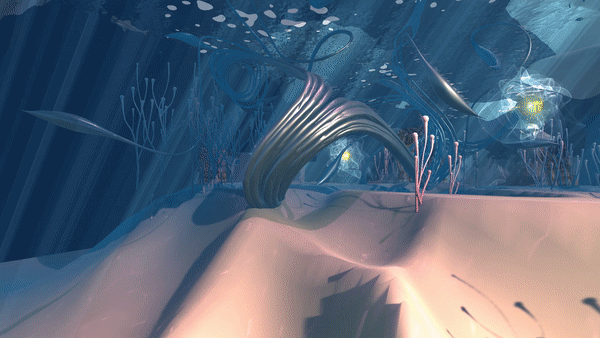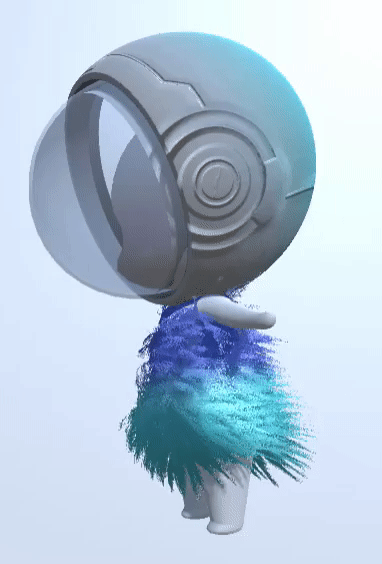top of page
BesideWild
Virtual reality | Game design | Interaction design | UI/UX design | Biosensory computing

This project explores family therapy in bipolar disorder through affective computing, emotion visualization, and gamification approaches. Based on the real-time health data from the emotional computing device Emotic, we establish a new way of communication between patients with bipolar disorder and their relatives or friends in a VR game.Bipolar disorder, formerly called manic depression, is a mental health condition that causes extreme mood swings that include emotional highs (mania or hypomania) and lows (depression).
In this project, patients play the role of explorers, whose emotional state is monitored in real-time through Emobitic, an emotion detection device worn on the wrist. Their mania, depression, and normal emotional states will be visualized in the game with sky, ocean, and shoal scenes. Whenever the patient's mood changes, the family's role as a supporter will rise or fall to the corresponding scene. The knowledge about the bipolar disorder will be gradually revealed to patients and families in the form of storytelling to understand the relevant information progressively and build trust in the entertainment process.
TOOL
Unity
Blender
Maya
Biosensory - EmotiBit
Human-centered design
Python
C#
MY ROLE
Scene design
3D modeling
Rendering
Interaction design
Biosignal interaction
User research
Storyboard
TEAM WITH
Zhiyue Wang
BACKGROUND
Bipolar disorder, formerly called manic depression, is a mental health condition that causes extreme mood swings that include emotional highs (mania or hypomania) and lows (depression).There are several types of bipolar and related disorders. They may include mania or hypomania and depression. Symptoms can cause unpredictable changes in mood and behavior, resulting in significant distress and difficulty in life. There are different types of bipolar disorders with different pattern of symptom: bipolar I disorder, bipolar II disorder, cyclothymic disorder, and dysthymia disorder

Approximately 10 million people in the United States have bipolar disorder, and their families and friends are also affected as they struggle to cope with its disabling effects on their loved one. Many approaches are used to treat bipolar disorder, including several types of psychotherapy along with medication. One bipolar therapy called family-focused therapy, or FFT, has proven successful for many bipolar patients, helping them become more stable and reduce the likelihood of relapses.
During family therapy, the therapist works to educate family members about bipolar disorder and related problems, including the burnout that many family members and other caregivers experience when dealing with a loved one who is bipolar. This psychotherapy technique aims to give families better communication skills so they can minimize stress and work together to solve problems, whether or not those problems are directly related to bipolar disorder.
Family-focused bipolar therapy sessions should teach participants how to:
.png)
Use better communication skills in order to engage more effectively and to resolve conflicts with fewer negative feelings.

Use problem-solving skills, including management strategies specifically designed to help with bipolar disorder

Identify bipolar disorder symptoms and recognize signs of impending episodes or relapses.

Take constructive steps and actions when the patient appears to be having significant difficulties with the illness
USER RSEARCH

We interviewed 6 participants (3 patients and 3 close family members/friends with patients) through video chat and face-to-face interviews about 30-60min. The participants' ages from 16-26, gender distribution 3:2:1 (female/male/others), Here are the sample questions and some quotes from participants.
-
What do you think about your intimate relationship?
-
Do you think your intimate relationship does benefit or harm your problem?
-
Can you describe how your family thinks about you?
-
Can you talk about your close people who suffer from this problem? Maybe you can talk about their attitude to you and their symptoms.
-
How much do you think you know about this bipolar disorder? Can you bring some examples you know about?
-
Have you ever tried family-focused therapy? How do you feel about it?
I am very strong willed and highly value independence so it wasn't easy asking for help. I feel like no one even cares that I'm reaching out to people and no one will listen, goes to show how messed up I am as I now have started drinking and I want to show them tonight that they are going to regret that. Why am I so stupid, I should of known that no one wants to help me, no one ever has and no one ever will.
My dad does have the problem and I have lived through his manic and depressive episodes for 7 or so years. (he had episodes before that but I was luckily shielded from it enough to not notice). I was always closer to my dad so when he became unwell, I felt like I had lost the person I would normally talk to things about which was incredible difficult. Its a lot of a teenager to take in and deal with.
I have hidden how bad my depression has been from my family for years. Eventually you do become really good at hiding it, its almost like its second nature (yes i know, its not healthy). But now that you have noticed it, try to be there for her, ask her how she is feeling about everything going on with her dad.
My wife has bipolar 2 and I think I find the hypomania harder to deal with than the depression. My wife is in hospital at the moment. I was a complete nervous wreck immediatly before she went in because I felt like I was on a 24 hour watch to make sure she didn't kill herself. I do feel a bit more relaxed with her getting some treatment in hospital but to be honest the hospitals are hopeless. I know she suffered a lot. But it’s really hard to completely understand the feelings and pains. Sometime I look at her and feel her very unfaniliar.


INSIGHT
%201.png)
Since it is hard for the family to truly understand how the patient feels. We want to use VR games to visualize emotion in the environment to let build empathy among them.
Visualize emotion and build empathy

Tasks collaboration
Inside the game, two players must collaborate and play together to collect the lights in the world. We hope collaboration will let them trust each other.
.png)
After light up the world, knowledges about bipolar disorder will appears in the buildings and environment. Both of the players will have a time to gain more knowledge about this problem.
Knowledge sharing
STORYBOARD

After a while, Cathy suddenly feels anxious and gets low emotional status. She is falling down from the sky.
With their effortness, they give the stars to the scene to light up the sad world.
With the lighting up, both of them see the heartfelt knowledge about Cathy’s situation. They feel very touched.
When all the darkness and chaos in the world light up, they feel closer to each other and more supportive.
Cahty and her best friend Anca get into the game together.
Cathy put on the Emotibit which can show her emotional arousal status.
Cathy is emotionally high now and the game starts at the cloud scene. Anca can feel her emotion through the chaotic atmosphere.
They explore the sky together and see a shining star. They chase the star and successfully collect it.

INTERACTIVE ARCHITECTURE

TECHNOLOGY


SCENE DESIGN

Mania status of CLOUD scene
Normal status of SHOAL scene


Depression status of SEABED scene
INTERACTION DESIGN

Collect Jelly Light from the scene.
Give out Jelly Light to light up the world.

CHARACTERS DESIGN








bottom of page